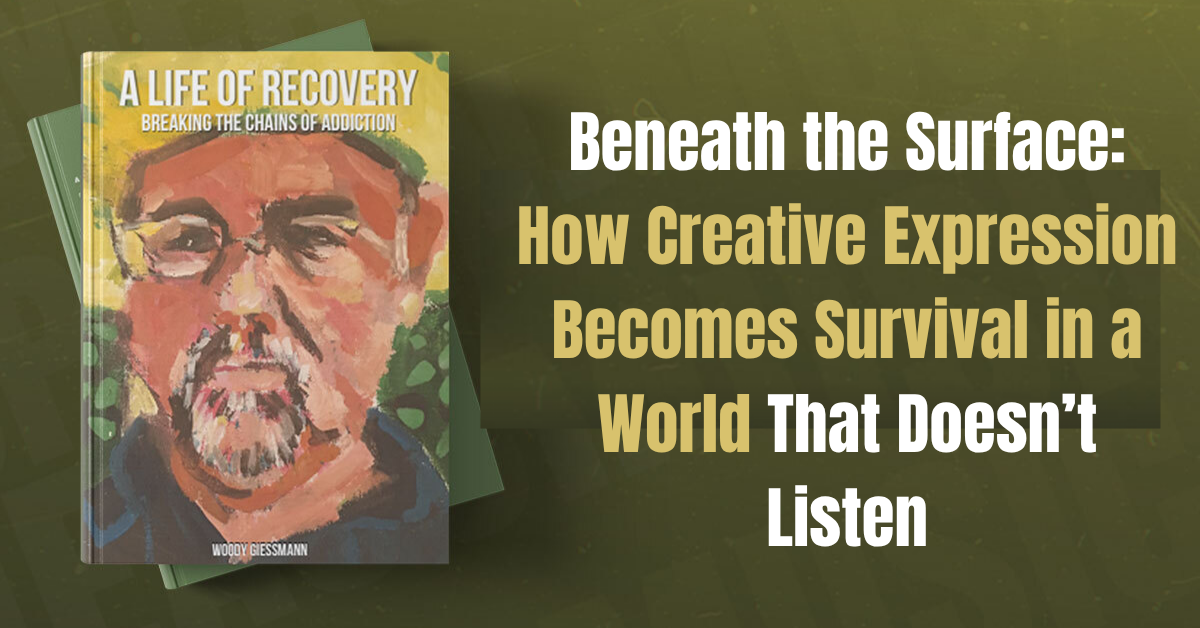There’s a quiet revolution in every person who finds a way to speak when no one taught them how. For Woody Giessmann, that revolution began in childhood—not with words, but with a paintbrush and a drumstick. Before he ever stepped into a recording studio or a recovery centre, before he ever spoke aloud the truth of his addiction or the trauma that preceded it, Giessmann learned to survive through creation. And A Life of Recovery is, at its deepest level, a story about the saving force of art.
What sets this book apart isn’t just its candid discussion of substance use, trauma, and healing. It’s how often Giessmann returns to the idea that creativity isn’t decoration. It’s oxygen. And not just for him but for the many people he has worked with as a counsellor, interventionist, and founder of a treatment centre that integrates the arts into recovery.
We often talk about the clinical side of addiction—treatment protocols, relapse rates, and dual diagnoses. But we don’t talk nearly enough about the psychic injury of being unseen. About what it does to a person to live for years, sometimes decades, without a reliable way to express their inner world. For many, that silence doesn’t break itself. And if talk therapy fails to touch the source of the pain, what then? What’s left when language falls short?
Giessmann’s answer is simple and radical: make something. Not to impress. Not to show. Just to survive. He shares how, as a kid, he would disappear into drawing for hours. Not because he was gifted or seeking praise but because it was the one place he could go where the noise of family tension and emotional confusion softened. Later, he found music, and drumming became a lifeline—a way to say things he didn’t yet know how to feel.
Even in the midst of addiction, music offered a kind of structure that held him. It gave him rhythm when his inner life was chaotic. After his near-death experience from a brain aneurysm, it was music and painting—not words or logic—that led him back to himself. This is more than a metaphor. He literally retrained his brain through rhythm. His physical and cognitive rehabilitation was supported by the very tools that had once saved his emotional life.
This thread—of art as a vehicle for healing—runs throughout the book but is never overstated. That’s part of its strength. Giessmann doesn’t romanticize creativity. He shows it for what it is: messy, private, imperfect, and vital. He doesn’t hold up a song or a painting as the end goal of healing but as a byproduct of showing up for your own experience. For him, and for many of the people he’s helped, creativity is the first safe space where healing becomes possible.
There’s something deeply resonant about this, especially in a culture where we are increasingly disconnected from our own expression. We live in a time where performance often replaces presence, where art is filtered and monetized before it’s even finished, where people are encouraged to create for validation, not integration.
Giessmann’s story pushes back against all of that. He reminds us that creative expression can be intimate and personal, not for an audience but for the self. It’s the act of tuning into your own voice when the world tells you to stay quiet. It’s colouring outside the lines because the page was never meant to hold everything you feel.
His work with Right Turn, the treatment program he founded, embodies this philosophy. The program combines evidence-based clinical treatment with opportunities for clients to engage in music, visual art, and creative writing. This isn’t art therapy in the traditional sense—it’s more fluid than that. It’s an acknowledgment that healing isn’t always linear or verbal. Sometimes, a song unlocks what a therapy session can’t. Sometimes, putting colour on a canvas gives form to a feeling that’s been buried for years.
Giessmann’s approach feels especially urgent for younger people navigating recovery. Teenagers and young adults, in particular, often struggle with the pressure to articulate their trauma in a way that others can understand. Creative expression offers a back door. It allows them to say something true without having to explain it. And for many, that’s the first step toward self-trust.
This idea also challenges the notion that creativity is a privilege or luxury. For those living with the aftermath of trauma or inside the fog of addiction, it can be one of the few accessible tools for reclaiming agency. You don’t need to be “talented” to pick up a pencil and draw the feeling you can’t name. You don’t need training to sit down with an instrument and let your fingers wander. You just need permission. And sometimes, that permission has to come from within.
By sharing his own messy, nonlinear relationship with art and music, Giessmann gives readers that permission. He doesn’t pretend that creating solves everything. But he shows that it opens a door. And for people who have felt trapped in silence or stuck in patterns they don’t understand, that door matters more than most would guess.
A Life of Recovery isn’t just a book about getting sober. It’s a quiet invitation to return to the parts of ourselves that have been long neglected. It’s about listening—to your grief, your joy, your confusion—and letting those feelings take shape in whatever form they need to. It’s about trusting that the act of making something, even something small and imperfect, is an act of defiance against despair.
In the end, Giessmann doesn’t tell us that art saved him. He simply shows us what it gave him—the space to survive when nothing else made sense. And in doing so, he leaves behind something just as valuable as a lesson. He leaves behind a rhythm. Something others can follow when their own voice feels far away.

